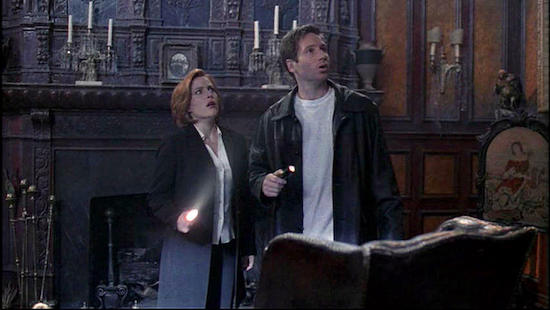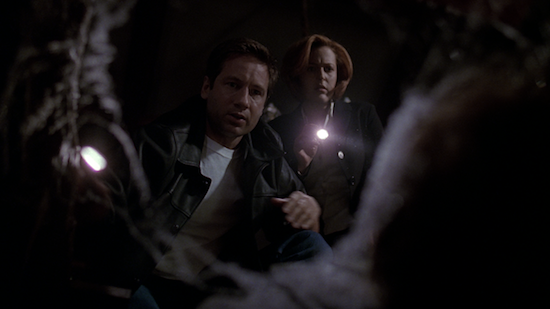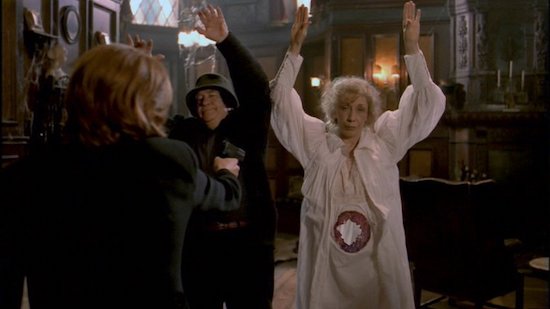THE X-FILES: Twenty Years Later, ‘How the Ghosts Stole Christmas’ Is Still a Gift
December 13, 2018 by Kelly Connolly

Scully (Gillian Anderson) and Mulder (David Duchovny) in THE X-FILES’ “How the Ghosts Stole Christmas.” (Credit: Fox)
It’s difficult to single out a definitive episode of THE X-FILES, a show that never wanted to be easily defined. But if you had to try, you could do a lot worse than “How the Ghosts Stole Christmas,” a holiday treat that comes almost dangerously close to embodying everything that makes Fox Mulder and Dana Scully work.
“How the Ghosts Stole Christmas” premiered 20 years ago, on Dec. 13, 1998, at the tail end of a creative string of episodes early in the show’s sixth season. This was an experimental time for THE X-FILES, which had just released a feature film and moved production to L.A. But “How the Ghosts,” which traps Mulder and Scully in a haunted house on the night before Christmas, manages to be fun without sacrificing the show’s contemplative core. It trades the usual feel-good sentimentality of seasonal TV fare for something thornier and much more interesting: a meditation on loneliness set inside a crackling ghost story.
It helps that “How the Ghosts” is essentially a four-person stage play, with two of the show’s most memorable guest stars—Ed Asner and Lily Tomlin—rounding out the cast as a pair of nosy spirits. In life, Maurice and Lyda were “star-crossed lovers” who died at their own hands in a murder-suicide, which Mulder spins as a “lovers’ pact” meant to ensure they’d “spend eternity together.” Now, the ghosts get their kicks driving couples mad until they make the same choice. The house has hosted three double murders over the last 80 years, all on Christmas Eve. Enter Mulder, drawn by the legends. Enter Scully, dragged by Mulder.
It’s no accident that THE X-FILES’ only haunted house story is set at Christmas rather than, say, Halloween; as Lyda puts it, “Now who is filled with hopelessness and futility on Halloween?” THE X-FILES sees Christmas as a holiday ripe for haunting. And that’s not just late-’90s cynicism talking—Dickens did it first, and writer-director Chris Carter positions “How the Ghosts” directly in that lineage when Mulder watches A Christmas Carol in black and white at the end of the hour. Even Scully admits that ghost stories and Christmas share the same impulses: Both are rooted in “the longing for immortality” and the hope “that we might never be long without our loved ones.” As a practicing Catholic, she’s implicitly including herself among the people who share that longing, even if she claims not to believe in ghosts.

(Credit: Fox)
In that sense, “How the Ghosts” starts with the idea of Mulder and Scully as believers, or at least people open to belief. Scully argues that ghost stories say more about the living than they do about the dead, and this ghost story is all about Mulder and Scully. The house becomes a sort of funhouse for their relationship, magnifying aspects of their fears about where that relationship is headed. They move through the house in circles, exiting a room only to wind up back in the same place. They climb a ladder only for the ladder to disappear, leaving them no way out. They’re separated by a brick wall only Mulder can see; they call out but can’t hear each other. Everything Mulder and Scully think about their partnership, which Scully said once was like going “two steps forward and three steps back,” is magnified here.
The ghosts play up these fears, using what Maurice calls a “pop psychology approach” (which he acknowledges is “crap”) to crudely psychoanalyze the agents as soon as they’re separated. Maurice tells Mulder that his quest for aliens is narcissistic and self-righteous. Lyda suggests Scully’s only joy in life is proving Mulder wrong. Both ghosts pick apart the partners’ twisted need for, in Lyda’s words, “intimacy through codependency,” working to convince the agents that they only stay together for selfish reasons. It doesn’t seem to be the first time Mulder and Scully have considered that possibility.
The approach succeeds at getting under the partners’ skin but fails at pushing them to commit murder, so the ghosts take matters into their own hands, using mind games to make Mulder and Scully believe they’ve each been shot by the other. Their trick leans on the romance that’s essential to the idea of Mulder and Scully, even when they’re not explicitly romantic: What can kill them is how badly they want to be together. Here, that’s true in a literal sense, but it’s also true for their partnership; in the first X-FILES movie, which premiered in the summer of 1998, months before “How the Ghosts” debuted, Scully quits the FBI rather than accept a transfer away from Mulder. What the ghosts exploit is that Mulder and Scully can’t figure out what their need to be together means or what to do about it.
And so they meet two ghosts who represent the aftermath of an eternal commitment—a nightmarish vision of what they both fear it would mean to be together forever. It’s as if they’re spending one long night with their personal ghosts of Christmas future. (Right after Scully mocks the idea that ghosts never age or change their hairstyles, she and Mulder are confronted with a vision of themselves as corpses, with the same hair and outfits, buried under the floorboards.) The ghosts continue to grow older after death. They’re marked by gunshot wounds that can never heal. They lost their romance a long time ago. The joke of the episode is that the usually unflappable Scully is so spooked by a pair of kindly old spirits; even she admits ghosts are an “irrational fear.” But sometimes irrational fears are the most personal.

Maurice (Ed Asner) and Lydia (Lily Tomlin), up to some ghostly mayhem. (Credit: Fox)
The scene at the heart of “How the Ghosts” comes near the end of the hour: Mulder and Scully, bleeding from wounds a ghost inflicted, drag themselves toward the door, Mulder army crawling through the trail of blood Scully left behind. (And this is THE X-FILES’ fun Christmas episode!) Scully says she’s not going to make it; Mulder counters, more right than he knows, “Not without me you’re not.” Alone, they’re dying; as soon as they actually communicate, the spell breaks. “It’s all in your head,” Mulder tells Scully, and her illusion shatters with his.
Like kids on Christmas morning, the partners make a break for it as Bing Crosby’s “Have Yourself a Merry Little Christmas” soars into the foreground of the scene. In one of THE X-FILES’ all-time great shots, the camera pans up Mulder and Scully as they cross the threshold of the house and the blood streaked down their clothes disappears. They were never really trapped by anything more powerful than suggestion—their relationship can survive if they just get out of their own heads. Belief is almost always a matter of life or death for Mulder and Scully, but it feels magical distilled to its essence like this: The only belief that matters here is their belief in each other.
It isn’t that Maurice and Lyda were wrong about Mulder and Scully; it’s that trying to understand them as separate people will never yield the whole truth. Mulder and Scully are more than what the ghosts estimated them to be, simply by virtue of the fact that their own selfish interests matter less than their partnership. There’s something about the spark between these characters that can’t be understood or explained from the outside. In contrast to the ghosts, who disappear without an audience, Mulder and Scully are saved by what no one else sees. The camera is almost protective as it pans away from the partners at the end of the episode, alone together on Mulder’s couch, exchanging gifts.
“How the Ghosts Stole Christmas” probably shouldn’t be as accessible as it is. But because everything about the subtext between Mulder and Scully is the text of this episode, it manages to reward long-time fans without alienating new viewers. “How the Ghosts” sings on multiple levels: The performances and gags are entertaining, but the high-energy humor plasters over real vulnerability. It’s a sort of Dickensian morality tale twisted so that the only moral imperative is Mulder and Scully’s relationship. The ghosts force the partners to face the fear that they’re personally responsible for their own suffering, but in the process they dig up something more potent: the fear that they’re also personally responsible for their own happiness.
RELATED:
- THE X-FILES’ 20th Anniversary: ALIAS and FRINGE Boss Jeff Pinkner Talks About Its Influence on His Work
- THE X-FILES’ 20th Anniversary: BONES Creator Hart Hanson Talks About Its Influence on His Work
Follow @GiveMeMyRemote and @_kellyQ on Twitter for the latest TV news. Connect with other TV fans on GIVE ME MY REMOTE’s official Facebook page.
And be the first to see our exclusive videos by subscribing to our YouTube channel at youtube.com/givememyremotetv
Related Posts
Filed under #1 featured, The X-Files



Thank you for this beautiful article I love your analysis of this episode which is in my top 10